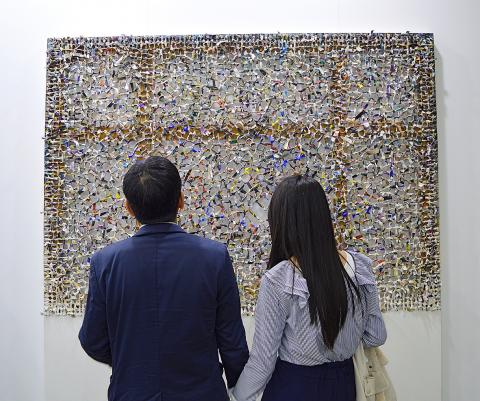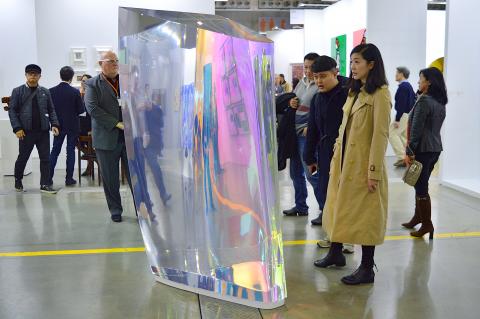Following the success of last year’s inaugural event, Taipei Dangdai (台北當代) is back for its second edition today through Sunday. The contemporary art fair presents renowned and young galleries, as well as solo exhibitions from the likes of Christopher Le Brun, recent president of the Royal Academy of Arts. The fair is complete with a salon section, where collectors can choose from artworks starting from US$8,000.
During this time, contemporary art will take over many sites in Taipei, including a light show at Taipei 101, designed by Tokyo-born Taiwanese artist Michael Lin (林明弘), from 6:30pm to 7pm every evening. Other off-site highlights include a major installation by Chinese artist Ai Wei Wei (艾未未) at Chambers Fine Art and Zhao Gang’s (趙剛) exhibition presented at Each Modern.
Ticket holders may attend talks with artists at Dangdai’s Ideas Program, focusing on the fair’s central themes: technology, ecology, pop and tradition. Highlights include a talk with Colombian artist Oscar Murillo, whose works focus on universal human experiences in an increasingly globalized world. Guided tours are also available in Chinese and English. Pre-booking is essential due to the limited number of participants per tour.

Photo: Ella Csarno
■ 1am to 6pm today and tomorrow, 11am to 5:30pm Sunday, Taipei World Trade Center Nangang Exhibition Hall (台北世界貿易中心南港展覽館), 1 Jingmao 2nd Rd, Taipei City (台北市經貿二路1號)
■ Advance tickets are NT$550 for today and NT$625 for tomorrow and Sunday, NT$750 at the door. For more information, visit /taipeidangdai.com

Photo: Ella Csarno

In Taiwan there are two economies: the shiny high tech export economy epitomized by Taiwan Semiconductor Manufacturing Co (TSMC, 台積電) and its outsized effect on global supply chains, and the domestic economy, driven by construction and powered by flows of gravel, sand and government contracts. The latter supports the former: we can have an economy without TSMC, but we can’t have one without construction. The labor shortage has heavily impacted public construction in Taiwan. For example, the first phase of the MRT Wanda Line in Taipei, originally slated for next year, has been pushed back to 2027. The government

July 22 to July 28 The Love River’s (愛河) four-decade run as the host of Kaohsiung’s annual dragon boat races came to an abrupt end in 1971 — the once pristine waterway had become too polluted. The 1970 event was infamous for the putrid stench permeating the air, exacerbated by contestants splashing water and sludge onto the shore and even the onlookers. The relocation of the festivities officially marked the “death” of the river, whose condition had rapidly deteriorated during the previous decade. The myriad factories upstream were only partly to blame; as Kaohsiung’s population boomed in the 1960s, all household

Allegations of corruption against three heavyweight politicians from the three major parties are big in the news now. On Wednesday, prosecutors indicted Hsinchu County Commissioner Yang Wen-ke (楊文科) of the Chinese Nationalist Party (KMT), a judgment is expected this week in the case involving Hsinchu Mayor Ann Kao (高虹安) of the Taiwan People’s Party (TPP) and former deputy premier and Taoyuan Mayor Cheng Wen-tsan (鄭文燦) of the Democratic Progressive Party (DPP) is being held incommunicado in prison. Unlike the other two cases, Cheng’s case has generated considerable speculation, rumors, suspicions and conspiracy theories from both the pan-blue and pan-green camps.

Stepping inside Waley Art (水谷藝術) in Taipei’s historic Wanhua District (萬華區) one leaves the motorcycle growl and air-conditioner purr of the street and enters a very different sonic realm. Speakers hiss, machines whir and objects chime from all five floors of the shophouse-turned- contemporary art gallery (including the basement). “It’s a bit of a metaphor, the stacking of gallery floors is like the layering of sounds,” observes Australian conceptual artist Samuel Beilby, whose audio installation HZ & Machinic Paragenesis occupies the ground floor of the gallery space. He’s not wrong. Put ‘em in a Box (我們把它都裝在一個盒子裡), which runs until Aug. 18, invites